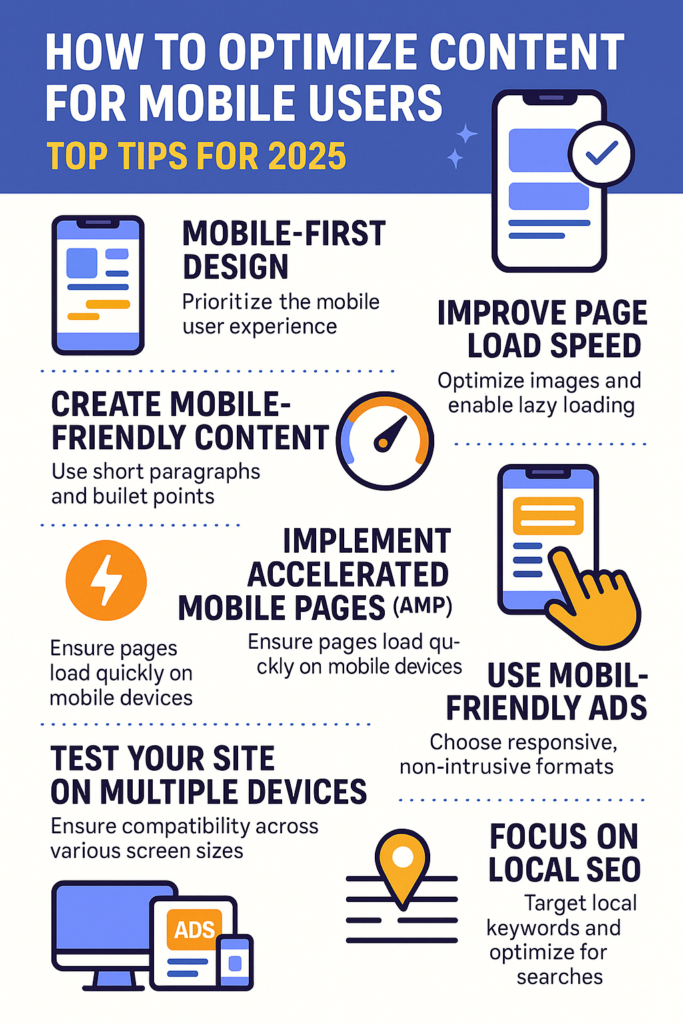Optimize Content for Mobile Users
In the world of digital marketing, one thing is clear: mobile usage is dominating the internet. According to recent statistics, over half of global web traffic now comes from mobile devices. If you’re not optimizing your content for mobile users, you’re missing out on a huge audience. In this blog, we’ll discuss how you can make sure your content is mobile-friendly and delivers the best experience for your users.
1. Prioritize Mobile-First Design
Mobile-first design is a web design philosophy that prioritizes the mobile user experience before designing for desktop. This approach ensures your site’s functionality and content are optimized for smaller screens. A mobile-first approach doesn’t just improve the user experience; it also plays a vital role in SEO, as Google now uses mobile-first indexing. This means Google evaluates the mobile version of your site for ranking.
Key Tips for Mobile-First Design:
- Responsive Layout: Use a responsive design that automatically adjusts to different screen sizes.
- Simplified Navigation: Keep the menu simple, using dropdowns or collapsible elements that work well on mobile.
- Readable Fonts: Use larger fonts that are easy to read on smaller screens (at least 16px for body text).
2. Improve Page Load Speed
Mobile users are typically on the go, and they don’t have time to wait for slow-loading websites. A delay of even a few seconds can cause users to bounce off your site. Page speed is also a ranking factor in Google’s algorithm, so improving your load time can boost your SEO.
Tips to Boost Mobile Page Speed:
- Optimize Images: Compress and resize images to reduce file sizes without sacrificing quality.
- Minimize HTTP Requests: Reduce the number of elements (like scripts and images) that your website needs to load.
- Use Lazy Loading: Implement lazy loading for images and videos so that they only load when they are about to be viewed.
3. Create Mobile-Friendly Content
Content is key to keeping users engaged, but it needs to be optimized for mobile viewing. Long paragraphs and large blocks of text can overwhelm mobile users. To ensure your content is mobile-friendly, aim to make it easy to digest and visually appealing.
Mobile-Friendly Content Tips:
- Short Paragraphs: Break up long paragraphs into smaller, digestible chunks.
- Bullet Points: Use bullet points to make key information easy to scan.
- Visuals: Incorporate high-quality images, infographics, and videos that help convey your message.
- Avoid Pop-ups: Pop-ups can be frustrating for mobile users, especially when they block content or are hard to close.
4. Optimize for Touchscreen Interaction
Mobile users interact with your website using their fingers, not a mouse. Therefore, it’s important to ensure that buttons and interactive elements are easy to click and don’t require precision tapping.
Tips for Touchscreen Optimization:
- Large Buttons: Ensure that buttons and clickable areas are large enough for users to tap easily.
- Avoid Hover-Based Interactions: Since mobile users can’t hover, make sure that all interactive elements work on tap.
- Easy-to-Use Forms: Simplify forms and make them easy to fill out on mobile. For example, use input masks for phone numbers and email addresses.
5. Implement Accelerated Mobile Pages (AMP)
Accelerated Mobile Pages (AMP) is a technology that allows you to create mobile-optimized content that loads almost instantly. By using AMP, you ensure your content is fast, lightweight, and suitable for mobile devices, improving the user experience.
How AMP Helps:
- Fast Load Time: AMP pages load faster, reducing bounce rates.
- SEO Benefits: AMP can help improve rankings by providing faster loading times for mobile users.
- Engagement: Since AMP pages are optimized for mobile, they are more likely to be shared, increasing your visibility.
6. Use Mobile-Friendly Ads
If you’re using ads as part of your content strategy, ensure they’re optimized for mobile. Intrusive or poorly designed ads can disrupt the mobile user experience, leading to higher bounce rates.
Tips for Mobile-Friendly Ads:
- Responsive Ads: Use ad units that automatically adjust to different screen sizes.
- Non-Intrusive Formats: Avoid pop-up or full-screen ads that are hard to close on mobile.
- Fast Loading Ads: Ensure that your ads load quickly and don’t slow down your page.
7. Test Your Site on Multiple Devices
Even if your website looks great on one mobile device, it may not perform well across all of them. Regularly testing your site on different devices and screen sizes helps identify potential issues that may affect the user experience.
Mobile Testing Tools:
- Google Mobile-Friendly Test: Use this free tool to check if your website is optimized for mobile users.
- Browser Developer Tools: Test your site’s mobile performance by simulating different devices through your browser’s developer tools.
8. Focus on Local SEO
Mobile users often search for businesses and services near them. For this reason, local SEO is especially important for mobile optimization. Ensure your business’s name, address, and phone number (NAP) are consistent across the web, and use location-based keywords to target local customers.
Local SEO Tips for Mobile:
- Google My Business: Set up and optimize your Google My Business profile.
- Local Keywords: Use location-based keywords in your content to help mobile users find your business.
- Mobile Reviews: Encourage customers to leave reviews, as they play a significant role in local search rankings.
Conclusion
Optimizing your content for mobile users is not just a trend, it’s a necessity. With mobile traffic continuing to rise, providing an exceptional mobile experience will help you increase user engagement, improve your search rankings, and ultimately boost your conversions. Implement these mobile optimization strategies to stay ahead of the competition and create a seamless experience for your mobile audience.
By ensuring your website is mobile-friendly, you’re not just keeping up with the times—you’re leading the way in providing an exceptional user experience.
For more such content check out more article here Trendify Digital
Facebook page: Trendify Digital
Instagram Page: Trendify Digital
